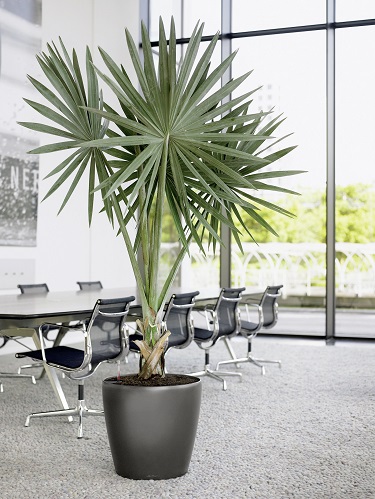
Bismarckia nobilis or Bismarck Palm is an extraordinary palm that has huge palmate leaves that are light blue, waxy, and can grow to several feet across, supported by large stems. The leaf bases split where they attach to the trunk (like those of Sabal Palmetto) and the leaf stems are armed with small, sharp teeth.
Palms are not typical trees. Instead of branching out, they grow huge leaves from a giant bud at their apex. The palm grows taller as this bud keeps producing new leaves and the lowest leaves die and fall. Next to the grasses, the palm family is most important in its usefulness to man. In some tropical countries, a large part of the economy is based on palms, with the trees supplying food, shelter, and clothing. Worldwide, palms are an important source of food, vegetable oil, and sugar. They also provide timber, fiber, rattan cane, carnauba wax and button ivory. We use them for everything from fuel and shampoo to the coconut seasoning of cakes and curries. Palms are planted as ornamentals for indoor and outdoor use to provide a tropical atmosphere.
Fun Facts
The Bismarckia nobilis was first discovered in Madagascar, an island country to the southeast of Africa. The palm was given its name by Otto Von Bismarck, a German chancellor in the 19th century.
Domestic Bismarck Palm can grow up to 30-40 feet tall and 20 feet wide, but in the wild it can reach 70 feet. It is a fast-growing palm that can grow from 3 feet to 15 feet tall in 5 years.
Related Articles & Free Email Newsletter
Bromeliads are a Great Plant for Your Greenhouse
Cacti are a Great Plant for Your Greenhouse


Comment here